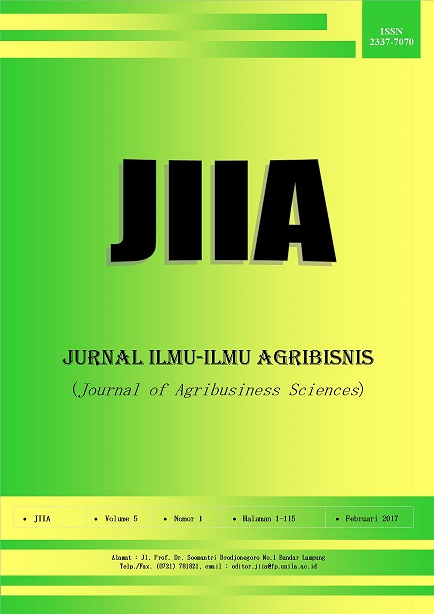ANALISIS PERBANDINGAN USAHATANI PADI SISTEM TANAM JAJAR LEGOWO DENGAN SISTEM TEGEL DI KECAMATAN SEPUTIH MATARAM KABUPATEN LAMPUNG TENGAH
DOI:
https://doi.org/10.23960/jiia.v5i1.1669 Abstract View: 1069
Abstract View: 1069
Abstract
The study aims to determine comparison of cost structure of rice farming with’ jajar legowo’ and ‘tege’l planting systems and comparison of income of farmers applying’ jajar legowo’ and ‘tegel’ systems in Seputih Mataram Sub-District of Central Lampung Regency. The study used a survey method. The location is determined purposively where ‘jajar legowo and tegel’ planting systems are implemented and it has the highest rice production in Central Lampung Regency.. Total samples are 30 farmers chosen randomly. This study was conducted in August 2015 to May 2016. This research uses ratio analysis. The results showed that the production cost of ‘jajar legowo’ planting system was higher than that of ‘tegel’ system especially pesticide and labor costs. The rice farming income with ‘jajar legowo’ was bigger than ‘tegel’ system.
Key words : comperative income, ‘ jajar legowo’,’ tegel’
Downloads
Downloads
Published
How to Cite
Issue
Section
License
Authors who publish with this journal agree to the following terms:
Authors retain copyright and grant the journal right of first publication with the work simultaneously licensed under a Creative Commons Attribution License that allows others to share the work with an acknowledgement of the work's authorship and initial publication in this journal.
Authors are able to enter into separate, additional contractual arrangements for the non-exclusive distribution of the journal's published version of the work (e.g., post it to an institutional repository or publish it in a book), with an acknowledgement of its initial publication in this journal.
Authors are permitted and encouraged to post their work online (e.g., in institutional repositories or on their website) prior to and during the submission process, as it can lead to productive exchanges, as well as earlier and greater citation of published work (See The Effect of Open Access).














